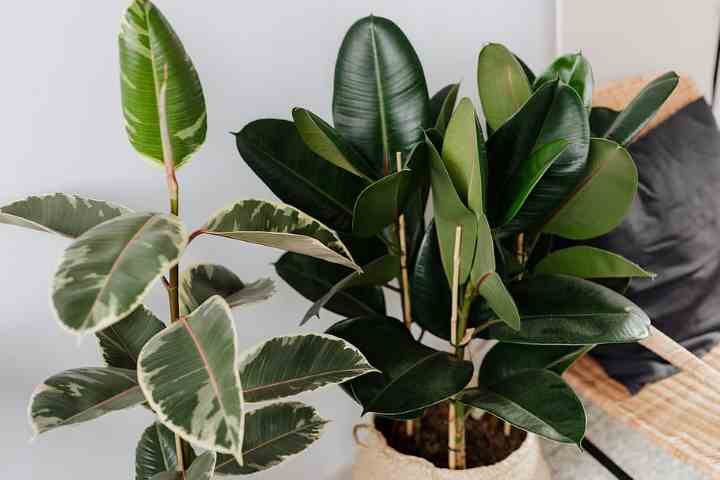Learn how to grow and care for Rubber Fig!
Rubber Fig (Ficus elastica) is a species of evergreen tropical tree native to southern China, Southeast Asia, and Indonesia. Belonging to the fig family, Moraceae, it was used for its latex sap to make rubber before synthetics were made available. However, the bulk of rubber made naturally comes from Hevea brasiliensis. Many plants contain substantial amounts of isoprene, but these two plants contain enough in their latexy sap to be used to make rubber.
In addition to being useful for rubber, in tropical Northeastern India, F. elastica roots are used to make living bridges! A dead tree trunk is put across a river, and the F. elastica roots are guided along the trunk. As the trunk rots, the roots grow to the other side, and thicken, and more roots are trained to complete the bridge. The bridge resists wind and flooding well because it is flexible. Truly, this tree is elastic in more than one sense! Rubber trees make excellent houseplants, as they are low-light tolerant, and help clean the indoor air from pollutants.
About Rubber Fig

Rubber trees, formally ficus elastica, can be enjoyed as either medium-sized house plants or grown to become focal point, beautiful indoor trees. If you’re patient enough to grow your own, plants that start out younger when you buy them adapt better to indoor living than starting with a more mature plant. They can grow to impressive heights within a few years, especially if you put the plants outside during the summer. Keeping the plants in small pots will restrict their growth, if you want to keep them smaller.
Where to Grow Rubber Fig
Rubber plants do best in rooms with medium light levels, so not too close to a window or too far from it, and with a good level of humidity. A bathroom or kitchen makes a fine humid spot for it, but if you grow yours in a living room or bedroom, make sure you mist the leaves regularly or stand the pot on a tray of moist pebbles, to increase humidity.
How to Propagate Rubber Fig
Rubber plant propagates easily from cuttings. Take cuttings from the tips, about 10cm long. Strip leaves from the lower third and place in water for 30 mins. Then place your cutting in moist compost, seal a clear plastic bag over the pot and put in a bright place out of direct sun. You can also leave the cutting in water for several months, where it will develop roots and you can pot it on afterwards. However, rooting the cutting in compost is a more reliable method of propagation.
Grow and Care for Rubber Fig
Light
Like most plants in their genus, rubber plants love lots of bright, diffused light. They can tolerate soft morning sunlight but should be moved out of the line of harsh direct rays in the afternoon as they can singe the leaves. Plants that do not receive sufficient light will become leggy, lose their lower leaves, and their leaf color will become dull instead of glossy and vibrant.
Soil
When it comes to their soil composition, rubber plants aren’t picky. Typically, any good, fast-draining potting soil will likely do—many indoor gardeners opt for a cactus mix. In addition, rubber plants prefer an acidic soil mixture. Like fiddle leaf fig trees (which many believe they resemble), they also “eat” their soil and will eventually have their roots exposed. When this happens, simply top your pot with additional soil and it will not be an issue.
Water
Water your rubber plant frequently—they like to be kept steadily moist but not soaked. Rubber plants also are vulnerable to excessive dryness and don’t tolerate drought well. To check if its time for another watering, check the moisture levels in the first few inches of soil—if they’re dry and crumbly, it’s time to water your plant again.
Temperature and Humidity
Like other types of ficus trees, these plants are vulnerable to cool drafts. Unhealthy plants will become leggy, with stretching internodes, and the leaves might first turn yellow and then brown before dropping off entirely. Generally, rubber trees are best kept in moderate to warm temperatures between 60 degrees Fahrenheit and 75 degrees Fahrenheit, with moderate humidity as well. If your home tends to be dry, invest in a space humidifier to increase the levels.
Fertilizer
Feed the plant a weak liquid fertilizer throughout the growing season. They are relatively heavy feeders when healthy. Some experts recommend only lightly fertilizing indoor plants to prevent stretching and plants becoming root-bound because they grow too fast.














